#Dinkelbrot
Explore tagged Tumblr posts
Text

80% Wholemeal Spelt and Durum Wheat. Leavened by two preferments: Lievito Madre and rye sourdough. Cold proofing 🥶 for 18 hours.
A soaker of psyllium husks is not only healthy but provides moisture for the easy dry baking spelt.
#hkig#shatinbread#homebaker#germanbread#sourdough#sourdoughbread#���國麵包#speltbread#wholemealspelt#dinkelbrot
2 notes
·
View notes
Text
German cake appreciation post
Holy fuck why does nobody talk about this. Okay France has pastries and Italy has bread etc etc but Germany? Best cake in the world. Goddamn. There’s this giant range of traditional cakes that are sold by the slice so you try em all with a group of friends/family over coffee. There is cake Everywhere. Most of the time it’s Kuchen-not layered/frosted, like a coffee cake. That is usually sheetpan-baked and comes marbled with pudding, yoghurty cheese, cinnamon sugar, streusel, apple, plum, poppy seeds, berries, cheesecake, honeyed almonds………anything your sugar-loving heart could imagine. Kuchen also refers to what Americans would call tarts and pies. And then there are tortes, which are layered with all of the above plus ganache, frosting, more pudding, etc, more like an American layer cake. God i love it. I love it all. Genuinely have never had better cake in my life than here. I want to cry holy shit
#i gotta learn how to make all of it#some are even made with yeast#a lot have a special kind of yoghurt-like stuff called quark#never seen it in the US but I’ll figure it out#also the bread. THE BREAD.#the Brötchen…#which means breadlings lol#the Dinkelbrot and the rye breads and the seeded breads#the walnut breads#the fucking walnut breads my god#Brotzeit my love#the french have bread with cheese the germans have cheese with bread#breakfast lunch and dinner baby#…with Kaffee und Kuchen in between
6 notes
·
View notes
Text
Deutschribing Germany
Cuisine
Meal times
The German proverb Iss dein Frühstück wie ein Kaiser, Mittagessen wie ein König und Abendessen wie ein Bettler (Eat your breakfast like an emperor, lunch like a king, and dine like a pauper) sums up the German outlook toward meals.
A typical day begins with Frühstück (breakfast), when people drink coffee, tea, or hot cocoa and eat muesli with yogurt or milk or bread with butter, jam, honey, chocolate and hazelnut spread, sausage, or cheese. Some people also drink juice and eat a boiled egg. This usually takes place between 6 and 8 a.m. Children usually eat a mid-morning snack at school called Pausenbrot (recess sandwich) that consists of a sandwich, a piece of fruit, or a muesli bar. The adult version is called Zwischenmahlzeit (in-between meal).
Mittagessen (lunch) takes place between 12 and 2 p.m. A typical lunch dish includes potato salad with sausage or meatballs and meat with potatoes or vegetables. It is common for family members and friends to gather between 3 and 5 p.m. for Kaffee und Kuchen (coffee and cake).
Abendessen (dinner) is eaten between 6 and 7 p.m. Sometimes it is a light cold meal with bread and cold cuts, in which case it is called Abendbrot (evening bread). Dinner normally consists of a salad or soup, bread, cheese, meat or sausages, mustard, and pickles.
Dishes
German cuisine varies from region to region, and what is considered typically German is actually typical in the south, mainly Bavaria, where cuisine is similar to that in Austria. There are also international varieties such as doner kebab, pizza, sushi, Chinese food, Greek food, Indian food, and Vietnamese food.
Bread and sausage are staples of the German diet. There are about 600 types of bread and almost 1,500 sausage varieties, including Bratwurst (made of ground pork, beef, or veal and spices) and Weißwurst (white sausage eaten with sweet mustard, a pretzel, and beer).
The national alcoholic drink is beer, of which there are many varieties, including Helles (a pale lager beer produced in southern Germany), Radler (a beer mixed with lemonade), and Weizenbier (a top-fermented beer brewed with a large proportion of wheat relative to the amount of malted barley).
Berliner/Krapfen/Pfannkuchen
These sweet dough dumplings, filled with jam and glazed with powdered sugar, are known as Berliner in northern and western Germany, Pfannkuchen in eastern Germany, and Krapfen in southern Germany.

Birnen, Bohnen und Speck
Birnen, Bohnen und Speck (pears, beans, and bacon) is a dish made with pears, green beans, and bacon, accompanied by potatoes. It is eaten in Bremen and Lower Saxony.

Bratkartoffeln
Bratkartoffeln (fried potatoes) are fried potato slices with diced bacon and/or onions.
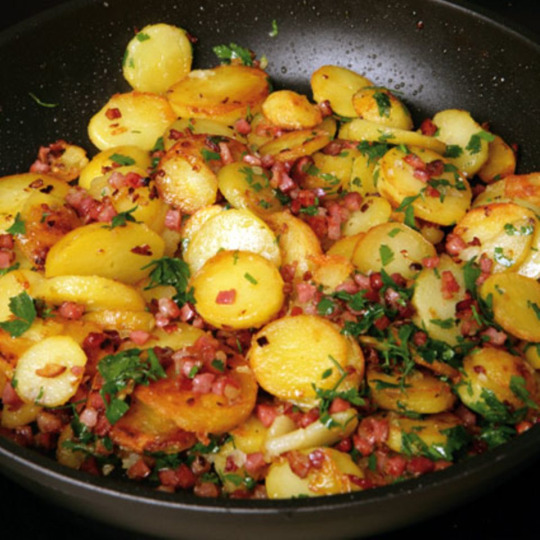
Brezel
Brezeln (pretzels) are baked pastries made from dough and shaped into a symmetrical knot. They are typically seasoned with salt, but can also have toppings such as cheese or seeds.
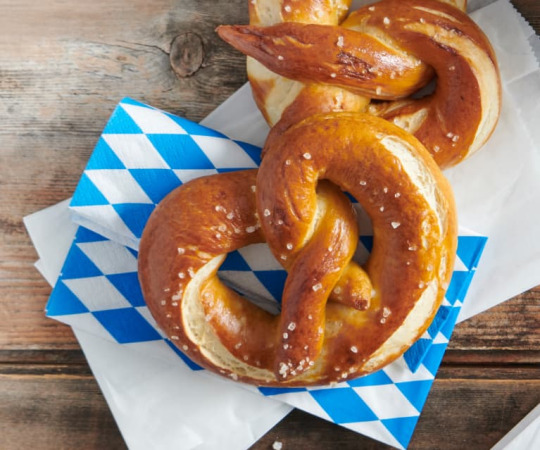
Brot
Brot (bread) comes in many different types, from white wheat bread (Weißbrot) to gray (Graubrot) to black (Schwarzbrot), which is actually dark brown rye bread. Some breads contain both wheat and rye flour and are called Mischbrot. Others have seeds such as linseed and sunflower seeds and are wholegrain (Vollkornbrot). Bread can also be made from spelt (Dinkelbrot), rye (Roggenbrot), or a mix of these with wheat.

Brötchen (bread rolls) are also very common and can be made from the same cereals and seeds as normal bread.
Currywurst
Currywurst is Berlin's most famous dish and consists of a pork sausage with ketchup and curry powder.
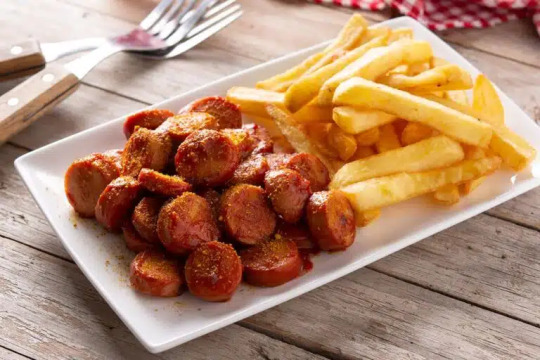
Eierschecke
Eierschecke, whose name is derived from a tripartite piece of clothing, consists of three layers: the bottom one is either a yeast dough or made with baking soda, the middle layer is a cream made of quark, vanilla, butter, egg, sugar, and milk, and the top one is made from eggs, butter, sugar, and vanilla pudding powder. It is a specialty from Saxony and Thuringia.
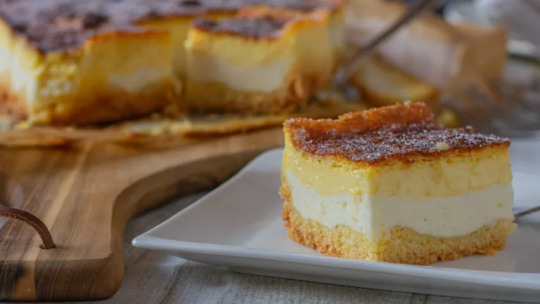
Fischbrötchen
A Fischbrötchen (fish bread roll) is a sandwich made with various fish, either pickled or fried, and onions, common in northern Germany.

Flammkuchen
Flammkuchen means "pie baked in the flames" and originates from Baden in Baden-Württemberg and the Palatinate in Rhineland-Palatinate. It is similar to a pizza with thin crust covered with crème fraîche, onions, and lardons.

Frikadellen
Frikadellen are flat-bottomed, pan-fried meatballs of minced meat. They are commonly eaten with pasta salad or potatoes, or in a bread roll with mustard.

Himmel und Erde
Himmel und Erde (heaven and earth) is a dish with mashed potatoes, stewed apples and fried blood pudding. Potatoes are also called Erdäpfel (ground apples), so it is a meal made with apples that grow above and under the earth. It is popular in the Rhineland in Rhineland-Palatinate and North Rhine-Westphalia, Westphalia in North Rhine-Westphalia, and Lower Saxony.
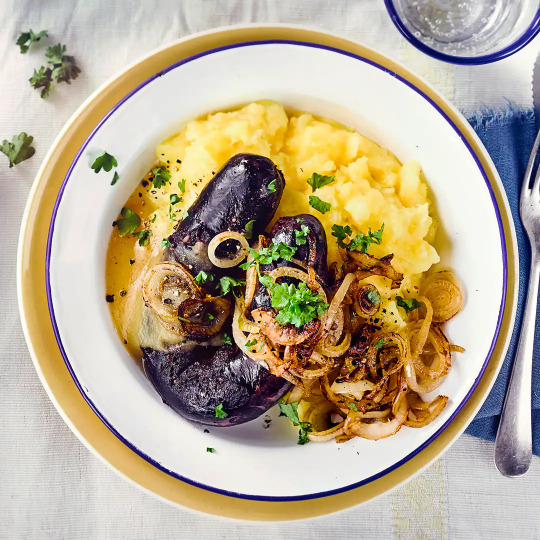
Kirschenmichel
Kirschenmichel is a kind of bread pudding made with cherries and served hot with vanilla sauce. It is typically eaten in Franconia in Bavaria and Thuringia, the Palatinate, Baden-Württemberg, and Hesse.

Klöße/Knödel
These dumplings are known as Klöße in northern, central, and western Germany and Knödel in southern Germany. They are usually made from flour, bread, or potatoes. There are different varieties, including dumplings made of ground liver or breadcrumbs.
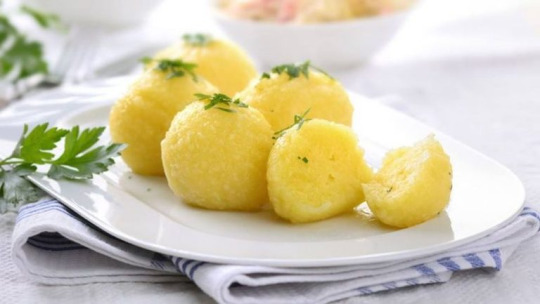
Kohlroulade
A Kohlroulade (cabbage roll) consists of cooked cabbage leaves wrapped around a meat filling seasoned with garlic, onion, and spices. Rinderrouladen are similar but consist of bacon and onions wrapped in beef.

Labskaus
Labskaus is a dish made from corned beef, herring, mashed potatoes, and beetroot, served with a fried egg and a pickled cucumber. It is typically eaten in northern Germany.
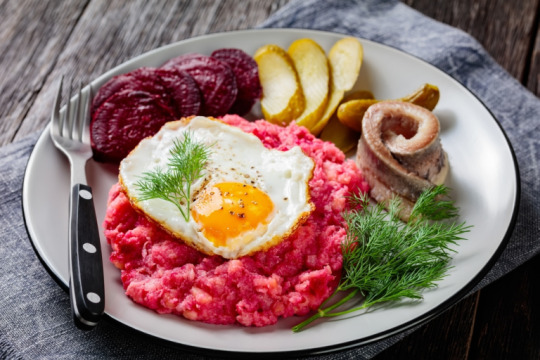
Leberkäse
Leberkäse ("liver-cheese") is eaten in Franconia, Saarland, and Swabia in Bavaria and Baden-Württemberg. It consists of beef, pork, and bacon that are finely ground and then baked as a loaf in a bread pan. It is served with an egg and mashed potatoes.

Leipziger Allerlei
Leipziger Allerlei was invented in Leipzig and consists of a mixture of peas, carrots, green beans, asparagus, morels, and celery. It may also contain broccoli, cauliflower, or corn. It is served with potatoes and a sauce made from crayfish butter, crayfish tails, and semolina dumplings.
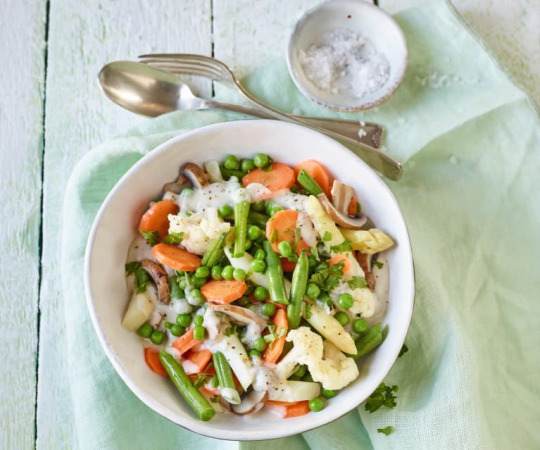
Marmorkuchen
Marmorkuchen (marble cake) has a streaked appearance, achieved by lightly blending light and dark batter. It can be a mixture of vanilla and chocolate.

Maultaschen
Maultaschen ("mouth bags") are large meat-filled dumplings typical of Swabian cuisine. They can also be filled with spinach, onions, and spices and can be either served with broth or cut into slices and fried with eggs.

Pfefferpotthast
Pfefferpotthast (boiled meat pepper pot) is a traditional Westphalian stew made with beef, lard, onions, and spices. It is served with boiled potatoes and salad in the summer and pickled cucumbers and beetroot in the winter.
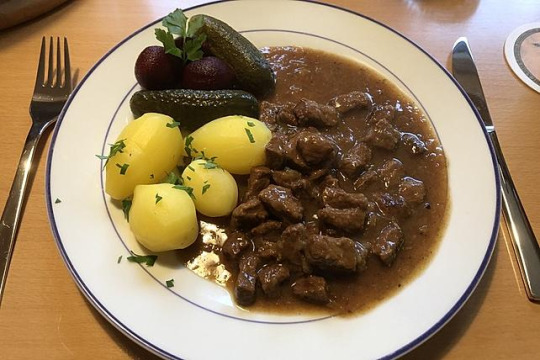
Pinkel mit Grünkohl
It is a dish made from slowly cooked kale served with Pinkel, a salty sausage eaten mainly in Bremen and Lower Saxony.
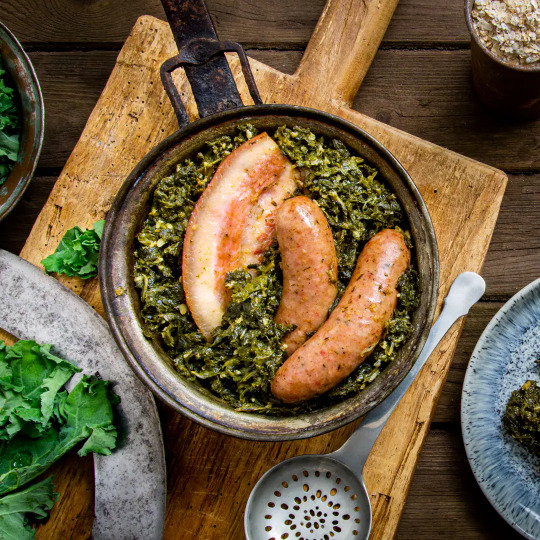
Quarkkäulchen
A Quarkkäulchen ("little quark ball") is a Saxon dish made from quark, mashed boiled potatoes, flour, an egg, and lemon peel. The dough is then baked in the form of a pancake and eaten hot with sugar and cinnamon or with fruit, whipped cream, and vanilla ice cream.

Reibekuchen
These potato pancakes are served with black bread, sugar beet syrup, or stewed apples. They are common in many areas of the country, but the name is characteristic to the Rhineland.

Rollmops
Rollmops ("rolled pug/fat young boy") are pickled herring fillets, rolled around a savory filling, usually consisting of onion and a pickle. It is a specialty from Berlin.

Sauerbraten
Sauerbraten is regarded as the national dish of Germany. It originally comes from the Rhineland and consists of large pieces of beef or horse meat, marinated in a spicy water-vinegar mixture before baking and served with Klöße.
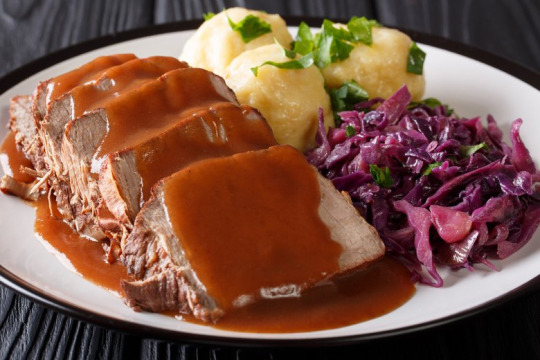
Sauerkraut
Sauerkraut is finely cut raw cabbage fermented by lactic acid bacteria.

Saumagen
Saumagen ("sow's stomach") is popular in the Palatinate and consists of a pork's stomach filled with pork, sausage meat, and potatoes. It is usually served with mashed potatoes or Bratkartoffeln and Sauerkraut.
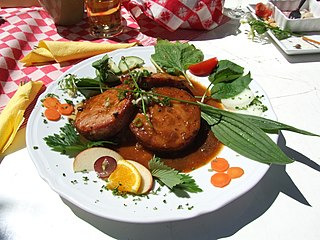
Schnitzel
A Schnitzel is a fried, breaded thin piece of meat, typically pork or beef. Although the most famous one is Wiener Schnitzel (Viennese style), there are other kinds, including Jägerschnitzel, with mushroom sauce; Rahmschnitzel, with cream sauce, and Zigeunerschnitzel, with a sauce made with tomato, bell peppers, and onion.

Schupfnudel
Schupfnudel are thick noodles typical of southern Germany. They are usually made from flour or potatoes and eggs and served with Sauerkraut.
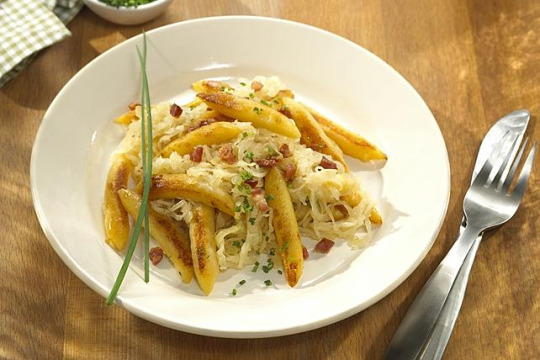
Schwarzsauer
Schwarzsauer ("black sour") is a North German blood soup with spices cooked in vinegar.

Schwarzwälder Kirschtorte
Black forest cake is a chocolate and whipped cream cake with a cherry filling and cherries on top.
Schweinshaxe
Schweinshaxe is a typical Bavarian dish of roasted ham hock served with Sauerkraut. A variation of this dish is known elsewhere as Eisbein ("ice leg"), in which the ham hock is pickled and slightly boiled.
Schwenkbraten
Schwenkbraten is a pork neck steak marinated in spices and onions. It is originally from the Saarland and grilled on a Schwenker, a grill that hangs on a chain over a wood fire.
Spaghettieis
Spaghettieis (spaghetti ice cream) is an ice cream dish made to resemble spaghetti. Vanilla ice cream is extruded through a modified Spätzle press to give it the appearance of spaghetti. It is placed over whipped cream and topped with strawberry sauce to simulate tomato sauce and either coconut flakes, grated almonds, or white chocolate shavings to represent Parmesan cheese.
Spätzle
Spätzle (little sparrow) are hand-made egg noodles, originally from Swabia. They are the main ingredient of several dishes, such as Käsespätzle (Spätzle with cheese) and Linsen mit Spätzle (lentils with Spätzle).
Streuselkuchen
Streuselkuchen ("crumb cake") is made of yeast dough covered with a sweet crumb topping (Streusel). The recipe originated in German Silesia.
45 notes
·
View notes
Link
0 notes
Text
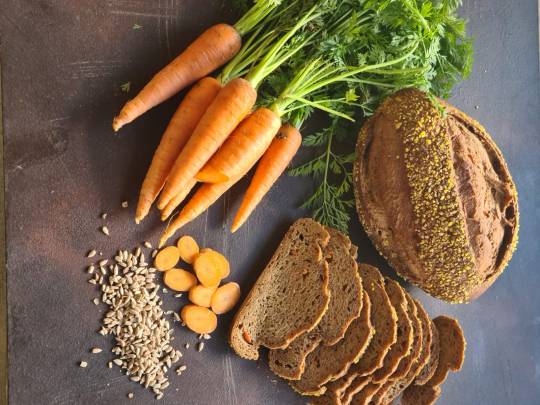
Unser „Hoppelbrot“, ein mild-aromatisches Brot aus Dinkel mit Karotten, Sonnenblumenkernen und gelbem Erbsenschrot sowie hauseigenem Sauerteig. Es ist eine wahre Gaumenfreude, perfekt für die festliche Ostertafel aber auch für jeden Tag des Jahres.
Der Duft von frisch gebackenem Brot erfüllt den Raum, während die goldene knusprig lächelnde Kruste Dich verführt, es schnell anzuschneiden. Die Kruste splittert zart beim Anschnitt und im Inneren enthüllt sich eine saftige, zarte Krume, die jeden Bissen zu einem Genuss macht.
Die Karottenstreifen verleihen dem Brot eine natürliche Süße und eine schöne Farbe, die sich perfekt mit den herzhaften Sonnenblumenkernen und dem nussigen Aroma des gelben Erbsenschrots verbinden. Der Sauerteig rundet den Geschmack mit seiner angenehmen Säure wunderbar ab. Der Schrotanteil im Brot bewirkt eine feste aber dennoch feine herrliche Textur.
Mit jedem Bissen dieses Dinkelbrots erlebt man eine harmonische Fusion von Aromen und Geschmäckern, die den Gaumen verwöhnen und den Geist beleben. Es ist nicht nur ein Brot, sondern ein Fest der Sinne, das jeden Anlass zu etwas Besonderem macht.
In diesem Sinne - lasst es Euch schmecken! Euer Brotsommelier!
0 notes
Text
Bio Hack Steak / Burger vom W;MF Grill .
Bio Hack Steak / Burger vom W;MF Grill ..leckere Bio Hack von meinem Metzger des Vertrauen gegrillt auf meinem WMF Grill ..lecker
2 Bio Hack Steak Patties
leckeres Dinkelbrot
Gurke
Tomate
ScheibenKäse Bio
Remulade & Ketchup
bei Interesse könnt Ihr den WMF Grill und die Zubereitung in laufenden Bildern Video in dem Kommentaren finden ! Schönes Weekend Tom
youtube
#cooking#recipes#bonappetit#Tips und Tricks#kochen mit tom#einfache leckere Rezepte#Kochen mit Tom#schnelle rezepte#easy recipes#how to cook#tastyfood#bbqlovers#shorts#wmf#biofleisch#burger#bbq#grillen#patties#hambuger#Empfehlungen#Grill rezepte#Indoor#Kontaktgrill#Youtube
0 notes
Text
West Africa states forming alliances as if they got that TNO mod/comic book nerd „who would win“ writing. Have they always been like this? Did those Jollof Yoruba kingdoms in the 1630s play these games with Tuaregs or are west Africans so high with their emotional IQ that they understand what makes for good entertainment. Not mutually exclusive.
that bio-Dinkelbrot spitz sanwich won me back over hard סליחה.
0 notes
Text

#Dinkelbrot mit #Sauerteig
DM1050, 20 % Dinkelsauer 24 Stunden mit TA200, 30 % DVT 24 Stunden mit TA200 und 2 % #Hefe, Röst- und Kochstück aus 10 % Dinkelflocken 1:4, Quellstück aus 2 % #Flohsamenschalen 1:20, 2 % Hefe, 2 % Salz, 1 % französische #Kräutermischung aus dem Bauernladen.
Im Haushaltsofen gebacken bei 220 Grad, die letzten 10 Minuten hoch auf 250 Grad und Umluft für eine vernünftige Kruste. Die Auswirkung des Sauerteigs auf das Volumen war hier minimal und somit zu vernachlässigen.
0 notes
Photo
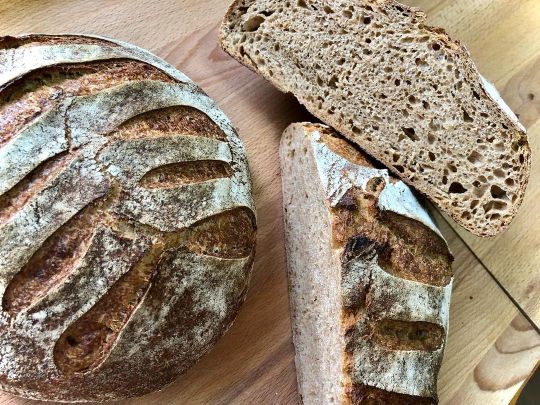
100% wholemeal spelt sourdough with ~15% sweet potatoes. Leavened by Lievito Madre in a salt sour way. Final proofing for 16-ish hours at 5C. Great bread, lovely crumb but the sweet potatoes killed a bit of spelt taste. For pure spelt taste psyllium husk is way better b/c a tiny amount soakes up lots of water without influencing the flour taste. Next check the influence of “ordinary “ potatoes. What is your experience? #speltbread #dinkelbrot #lievitomadre #sourdoughbread #sauerteigbrot #germanbread #wholemealbread #vollkornbrot #shatinbread #hkbread #hksourdoughbaker (at Sha Tin, Hong Kong) https://www.instagram.com/p/CpMQXhHoUqi/?igshid=NGJjMDIxMWI=
#speltbread#dinkelbrot#lievitomadre#sourdoughbread#sauerteigbrot#germanbread#wholemealbread#vollkornbrot#shatinbread#hkbread#hksourdoughbaker
0 notes
Text
🍞 Probieren Sie unser köstliches Weizenmehl-Dinkelbrot-Rezept! 🥖 Fluffig, aromatisch und knusprig - perfekt für Sandwiches, Toast oder als Beilage. Mit wenigen Zutaten wie Weizenmehl 405, Dinkelmehl und Trockenhefe ist es einfach zuzubereiten. Lassen Sie die Hefe aktiv werden, kneten Sie den Teig und lassen Sie ihn aufgehen. Nach dem Backen erhalten Sie ein einzigartiges Brot mit nussigem Geschmack. Reich an Ballaststoffen und Nährstoffen - gesund und lecker! Servieren Sie es mit Butter und Marmelade oder zu herzhaften Suppen und Eintöpfen. Genießen Sie dieses vielseitige Brot zu jeder Mahlzeit. 🥐
0 notes
Photo

Spelt (Triticum spelta), also known as dinkel wheat or hulled wheat, is a species of wheat that has been cultivated since approximately 5000 BC.
Spelt was an important staple food in parts of Europe from the Bronze Age to medieval times. Now it survives as a relict crop in Central Europe and northern Spain, and it has found a new market as a health food. Spelt is sometimes considered a subspecies of the closely related species common wheat (Triticum aestivum), in which case its botanical name is considered to be Triticum aestivum subsp. spelta.
In Germany and Austria, spelt loaves and rolls (Dinkelbrot) are widely available in bakeries, as is spelt flour in supermarkets. The unripe spelt grains are dried and eaten as Grünkern ("green grain"). In Poland, spelt breads and flour are commonly available as health foods and easy to find in bakeries.
Dutch jenever makers distill with spelt. Beer brewed from spelt is sometimes seen in Bavaria and Belgium, and spelt is distilled to make vodka in Poland.
1 note
·
View note
Text
I looked up brotschneidemaschine because I didn't know what that was (I mean I had an idea with the words brot and maschine) and I didn't know at home bread slicing machines existed.
Now that I don't work in a place with a bread slicer at the moment, I might need to invest in one.

heh, this picture reminds me of when I knew I truly won the hearts of my German friends when I brought them a loaf of dinkelbrot after they said they missed good bread while staying in America.
Detecting a grilled cheese deficit in my life.
10 notes
·
View notes
Link
0 notes
Text

Homemade toasted spelt bread with cashew butter, strawberries and banana 🍓🍌
#Bread#Cashewmus#cashew butter#spelt bread#Dinkelbrot#Vegan#plantbased#Breakfast#breakfast ideas#vegan breakfast#whatveganseat#veganfoodporn#veganfoodshare#veganfood#foodporn#healthy food#foodgasm#food#veganinspo#veganinspiration#food ideas#Vegan food ideas#vegangermany#vegandeutschland#nutbutter#Brot#Vegans#Yes its vegan#Veganism#Govegan
263 notes
·
View notes
Text

Herzhaftes Amaranth- Dinkel-Zwiebelbrot
Schmeckt sogar ohne Belag fantastisch!
Du brauchst:
~ 370 ml Wasser
100 g Amaranth
1 Päckchen Trockenhefe
500 g Mehl (Ich empfehle 2 Teile Dinkelvollkornmehl und einen Teil Hafermehl)
2-3 normalgroße Zwiebeln
1 Teelöffel Salz
1-2 Teelöffel Brotgewürz (Ich nehme fertiges Brotgewürz, bestehend aus Coriander, Kümmel, Fenchel, Anis)
Etwas Öl zum einfetten der Form
Zubereitung:
Den Amaranth mit der doppelten Menge Wasser bedecken und mindestens 8 Stunden einweichen lassen
Danach im Sieb abspülen und mit 270 ml Wasser aufkochen, dann die Hitze reduzieren und für 30 Min köcheln lassen
Den Amaranth vollkommen auskühlen lassen
Die Zwiebeln je nach Vorliebe fein schneiden
Alle Zutaten vermischen und kurz durchziehen lassen bis das Mehl die Feuchtigkeit vom Amaranth aufgenommen hat
Nun so viel Wasser dazugeben, bis der Teig eine angenehme formbare Konsistenz bekommen hat, bei mir waren das ungefähr 100 ml
Der Teig wird nun mit einem feuchten Tuch abgedeckt und an einen warmen Ort (z.B. Heizung) gestellt, bis er ungefähr um ein Drittel gewachsen ist (Normalerweise in 1-2 Stunden geschehen)
Die Form einfetten und den Ofen auf 170 °C Umluft (190 °C Ober-/Unterhitze) vorheizen
Die Backzeit beträgt 45 min (Eine kleine Schüssel Wasser im Backofen macht das Brot fluffig und sorgt für eine schöne Kruste)
Nach dem Backen kann man das Brot auch noch mit etwas Wasser besprühen, dann lässt es sich später besser schneiden
Wichtig, vor dem anschneiden sollte das Brot vollständig auskühlen
#vegan#bread#brot#rezepte#vegane rezepte#backen#baking#healthy#vegan recipes#vegan recipe#recipe#dinkel#spelt#whole grain#vollkorn#speltbread#dinkelbrot#hafer#hafermehl#oats#oatmeal#zwiebel#onions#zwiebelbrot#onion bread
12 notes
·
View notes
